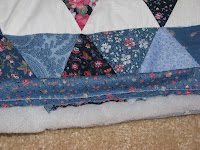Jean Purse
Couldn't let the jeans just sit there, after shortening jeans into shorts/bermudas. With the church bazaar around the corner, thought of some little purses. I still have some jean left over and planning something with those in the near future.
Directions: 1. From bottom of jean measure 8" and cut.
2. Lay cuff over scrap fabric folded in half. Cutting on fold; cut 1/4 larger
than jean (this is to give fabric for seam allowance. The bottom of your
fabric is the folded end.
3. Stitch sides of lining using 1/4" seam allowances.
4. Cut 1" square out of bottom as shown below out of lining and jeans. This will form a
base for the purse.
5. Fold cut edge together shown in below picture and stitch using 1/4" seam allowance.
Do same for lining.
6. Right side jean and insert liner so wrong sides are together.
7. Cut two 2 3/4" X 13" of scrap fabric. Sew along long side with right sides together.
Inside right. These will be the handles.
8. Place handles and tack into place.
9. Make sure liner is snug to bottom of purse. With raw edges of liner carefully fold them
and stitch into place.
10. Embelish as desire.
This makes cute little bags with free items around the house. The button flower was a piece of fabric sewn like the handles, however bunching the fabric and secured with a button.
Enjoy and keep sewing.












